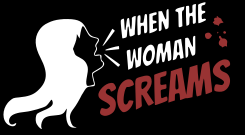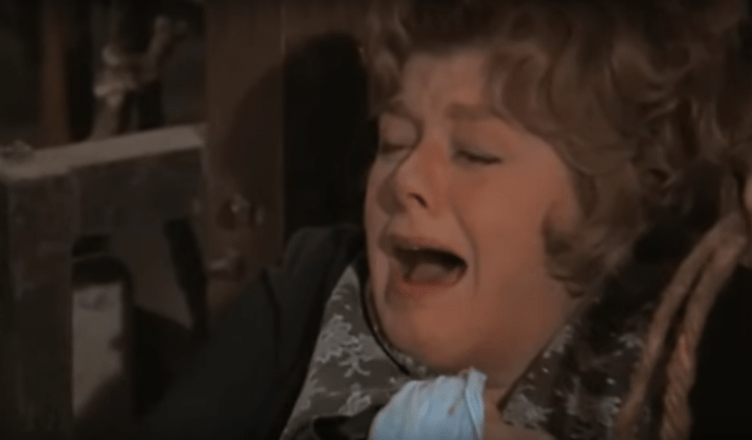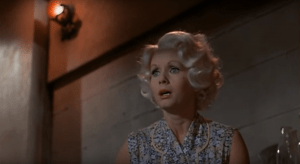Film Deets:
Director: Curtis Harrington
Screenplay: Henry Farrell
Actresses: Debbie Reynolds, Shelley Winters
Category: Hagsploitation
Themes: Grief Mental Illness
Why do these screams matter?
What’s the Matter with Helen follows two women, Adelle (Debbie Reynolds) and Helen (Shelley Winters), who flee their hometown for Hollywood when their sons are convicted of murdering a young woman. They open up a successful dance school for children but soon find their happiness threatened by a mysterious stalker.
In our first clip, Helen is backstage at the dance school recital when she begins hallucinating dead bodies. Her screams take on an added degree of hysteria when she then hallucinates that one of her colleagues has a knife.
Helen’s screams at this moment read as delusional paranoia since the audience can tell that the images Helen sees are not visible to any other characters. While Helen is legitimately afraid, the audience is not, and this juxtaposition frames Helen as an unreliable narrator. Unlike other hagsploitation films in which delusions turn out to be reality, and the message being conveyed is that women’s voices and experiences should be believed, this film takes the opposite approach: it doubles down on Helen’s madness. Her instability not only marginalizes her within the narrative but also implies that she is a bad mother. Unlike Adelle, whose nurturing of the young dancers implies her son’s failures are his own and not the result of poor mothering, Helen is framed as contributing to her son’s homicidal tendencies. Her screams, which disturb all around her including children, convey a psychotic break that doesn’t humanize Helen as much as it positions her as a potential monster.
By connecting Helen’s mental unraveling to her implied bad parenting, the film adopts a conservative stance in keeping with the time it was made. Deviance of the sort illustrated by her son’s crimes was thought to be the result of bad parenting, with mothers taking the brunt of the criticism. In a time when the medical profession connected everything from schizophrenia to developmental delays to the actions of the parents, Helen is the film’s easiest scapegoat. But why is Helen demonized while Adelle is not? The answer resides in our next scream.
Having started to realize the extent of Helen’s issues, Adelle watches Helen tend to her beloved rabbits before gazing off in a quiet state of reflection in a moment designed to signal that Adelle no longer knows how to handle Helen. A few moments later, Adelle hears Helen screaming and arrives to find a promotional cardboard cutout of herself covered in blood.
Functionally, this scream serves two purposes. First, it adds to the film’s dread-building by suggesting to the audience that the danger stalking the women is real and it is closing in on them. Because the scene comes on the heels of Helen seeing an image of a man standing outside in the shadows, the audience is left to wonder whether the man has finally infiltrated the “family” home. But this home is inhabited by two single women, something the film suggests makes the home simultaneously vulnerable and potentially abnormal.
Second, this scream is another way for the film to frame Helen as highly emotional and potentially erratic. Helen’s scream occurs in tandem with Adelle’s silence, with the film implying that Helen’s reaction is the extreme one. It is a bizarre narrative beat because objectively, Helen’s reaction is the expected normal response when confronted with a ghastly image. But instead, the film centers Adelle’s silence. While Helen unleashes a scream and then cowers in the face of the bloody spectacle, Adelle remains stoic and silent, approaching the cutout and removing the knife before shuffling Helen out of the room. The moment is a subtle bit of audience manipulation designed to Other Helen because no one who watches horror films imagines themselves as the character who panics and trembles in the face of danger. We imagine ourselves as the character who, like Adelle, confronts the danger.
The film extends Helen’s Otherness by connecting her bouts of hysteria with queer desire. Although the film’s intended lesbian subtext was dialed back in production, a fair number of queer markers made it into the final print. Helen continually vies for Adelle’s attention, she spends an inordinate amount of time commenting on Adelle’s beauty, and she verbalizes a vision of the future that prioritizes their relationship with one another. In an echo of the decade’s anti women’s liberation rhetoric, which conflated feminism with lesbianism, Helen’s infatuation with Adelle is designed to be read as perverse. Compared to Adelle, whose heteronormativity is conveyed through her romantic relationship with Lincoln (Dennis Weaver) and her highly feminized appearance, Helen is a marginalized figure in both appearance and action. It is this status that her scream reiterates to both Adelle and the audience.
Works Cited
Caplan, Paula J., and Ian Hall-McCorquodale. “Mother-Blaming in Major Clinical Journals.” The American Journal of Orthopsychiatry, vol. 55, no. 3, July 1985, pp. 345–353.
What’s the Matter with Helen. Directed by Curtis Harrington, performances by Debbie Reynolds, Shelley Winters, and Dennis Weaver, United Artists, 1971.







